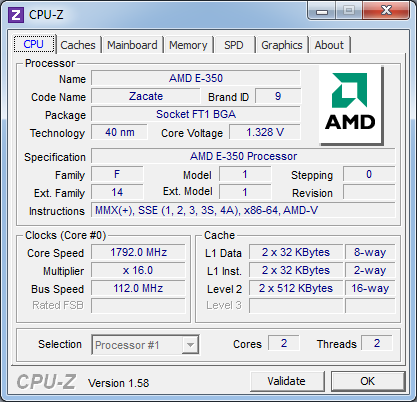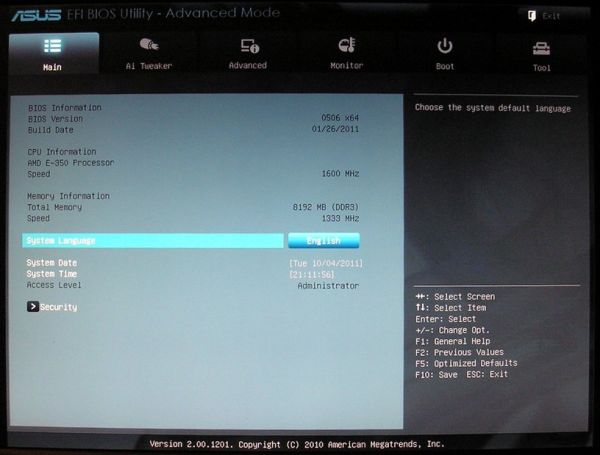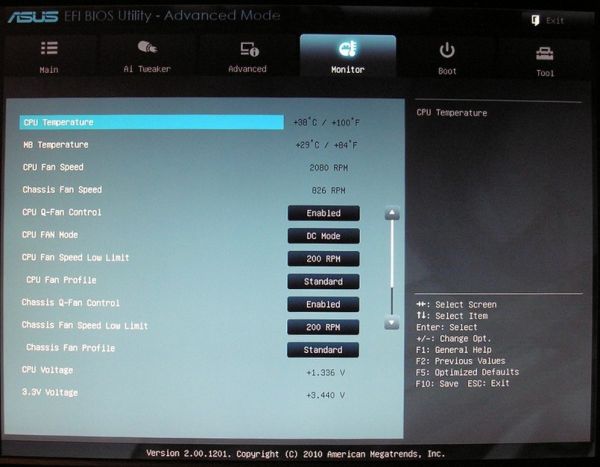ASUS E35M1-M Pro Review - Anyone For Fusion?
by Brendan van Varik on October 25, 2011 5:00 AM EST- Posted in
- Asus
- Motherboards
- Fusion
- E-350
BIOS
When you first enter BIOS, you will notice that ASUS have used a graphical BIOS with this motherboard. The BIOS itself is very easy to navigate through and when you get into it for the first time, you are faced with the ‘EZ Mode’ which shows you the basic things which a user may use or need to change such as the boot order of the system. When you enter the ‘Advanced Mode’, it opens up the entire BIOS so that you can turn things on or off which you would not find in the basic setup.
It is nice to see that overclocking features have been included in this BIOS but I do not think that many users will be buying this motherboard with overclocking in mind, as that will only raise power consumption and temperatures.
The fan controls in the BIOS allow you control both fan headers on the motherboard. You have a few options available which allow for either optimized cooling based on temperature, or if a quiet computing experience is preferred, that option is at your disposal too.
There are no noticeable changes between the release BIOS and the latest BIOS which is available on the ASUS website. ASUS claim improved system stability is achieved with the latest release although I have not experienced any issues on the shipped BIOS.
Overclocking
While overclocking may not be a strong point of this motherboard, it is still possible to squeeze a bit of extra performance out of the APU. I started with the ASUS Suite II software to see how good the automated overclocking was. The auto-overclocking feature added 3 MHz to the bus speed which increased the overall CPU speed by 48 MHz to give a final clock speed of 1648 MHz. The same overclock is applied if you select the AutoTune feature within the BIOS. It was stable but the increase in performance was not that noticeable.
Going through the BIOS, I was able to achieve a better result. The APU has a stock clock speed of 1.6 GHz and I was able to push it up to 1.792 GHz by using a 112 MHz base clock. All voltages were left on auto. When I went any higher than 112 MHz on the base clock, the motherboard would occasionally have an issue getting into Windows. However, from a stability standpoint, everything worked flawlessly at 112 MHz.

Along with standard stability tests, for completeness, the system was put under a 100 per cent loading for ten minutes and then the PC was put into a sleep state for the night. It switched on in the morning without any issues and full usability. When a 112 MHz base clock was used, there were no issues and the system was fully usable.


















66 Comments
View All Comments
C300fans - Tuesday, October 25, 2011 - link
No, because 80sp is really really too weak for gaming.C300fans - Tuesday, October 25, 2011 - link
Even if a 800sp card, GDDR5 128bit is far enough. Can you tell the difference between HD 6790 and HD 6770? I could say, you will probably notice more on the price.silverblue - Tuesday, October 25, 2011 - link
The difference here is that the memory interface is shared by both the CPU and the GPU. It's not all about gaming, but the actual effective use of what's on offer.However, being a geek at heart, I wouldn't mind seeing what the turbo mode plus more memory bandwidth would do for light gaming as well as if the E-450 is only a tiny bit faster than the E-350 even with the extra bandwidth.
duploxxx - Tuesday, October 25, 2011 - link
its already been tested, between 5-10% more perf in general tasks with same consumption. Not bad at all for a small update. No graphics tested yethttp://asia.cnet.com/product/hp-pavilion-dm1-amd-f...
lestr - Tuesday, October 25, 2011 - link
Lap top/netbook review, does not equal desktop especially in a "review" that is a mere single page, maybe two, max. The 350 OC's to ~1.8 +/- and with memory upped to 1600 on a 6320 graphics core the results might be more interesting especially since folks are only now beginning to understand how to OC an APU properly. Drop the mult, crank the FSB for graphics and raise both to stable. That noted, it's certainly not about gaming but over all performance. 80SP's isn't much but more power/speed wouldn't hurt, now would it? 160 would be great. Maybe CPU can get to 2.0 or greater...
Also promised are reviews geared more toward HTPC use rather than gaming... that's like trying to take out an elefunk with a BB gun. Not much point in even going there.
Actually I am more interested in what is going to replace the M50 - 350/450 line - Jan? For now it looks like they're trying to deplete 350 inventories before bringing the 450 here. Even so, a lot of people would like to know.
thanks it's nice to see the interest.
rburnham - Tuesday, October 25, 2011 - link
This board seems too big for an HTPC and too underpowered for a gaming rig. Most people I know who use their computers for basic things (web browsing, spreadsheets) already have laptops and they prefer the portability over a desktop. I am not sure where this board fits in.mino - Wednesday, October 26, 2011 - link
This board is actuall;y great for HTPC for a very important reason - there are people who actually _need_ more than a single PCIe or PCI slot ...But otherwise, the real target would be cheap PC's for kids, secretaries and the like.
jrs77 - Tuesday, October 25, 2011 - link
I'm owning a Zotac IONITX A-E (used as NAS/webclient), an Asus AT3IONT-I Deluxe (used as HTPC) and a Lenovo Thinkpad x121e E350 (for travelling and whatever). All of them are basically the same when it comes to powerconsumption and they're all up to the task of playing Full HD-media.People will allways moan about the low-power CPUs of those systems, but if you don't do anything else then browsing the web and playback some media, there's nothing to complain about really. These systems even run older games perfectly fine, or they make for a good system to run a second client for EvE Online, etc.
Geofram - Tuesday, October 25, 2011 - link
In windows, will it stream Netflix without a problem?I used to have a Atom based HTPC, and HD content on Netflix wouldn't properly use the GPU acceleration, and hence, it wouldn't play smoothly. Something in the Silverlight acceleration didn't detect and use GPU for everything, and would fall back to CPU. So I'm more worried about that than I am about if it will play a Blu-ray, yet it's something I never see checked.
RayMort - Wednesday, October 26, 2011 - link
This is exactly what I need to know too. My 6 year old PC with an AMD 3500 dual core processor can't decode Netflix HD streaming for the same reasons. I want to upgrade, but I want to be sure it will do Neflix HD before I purchase.